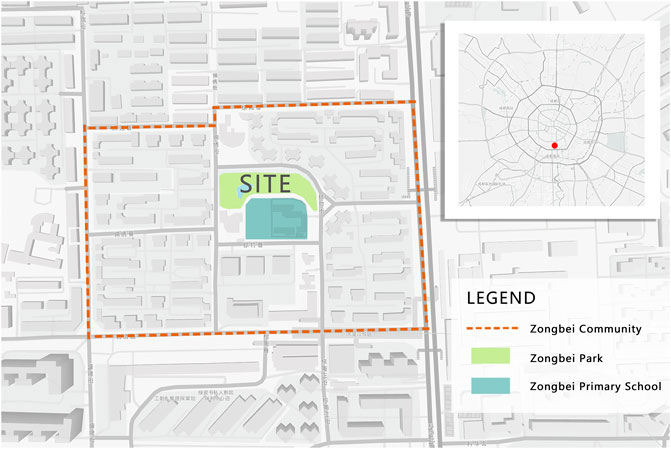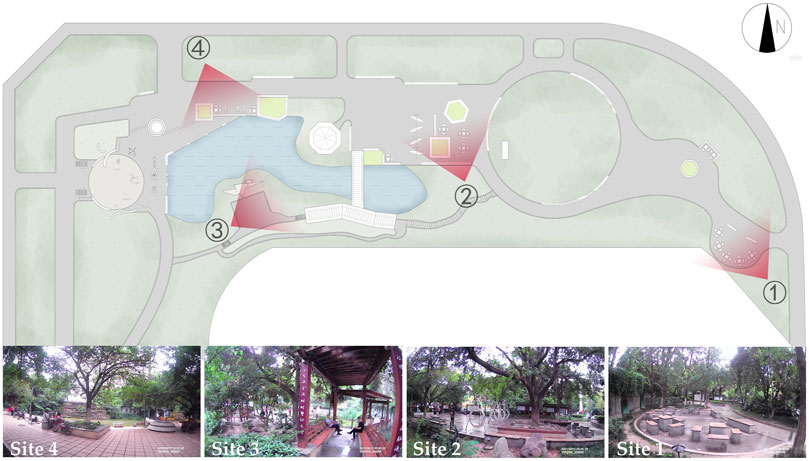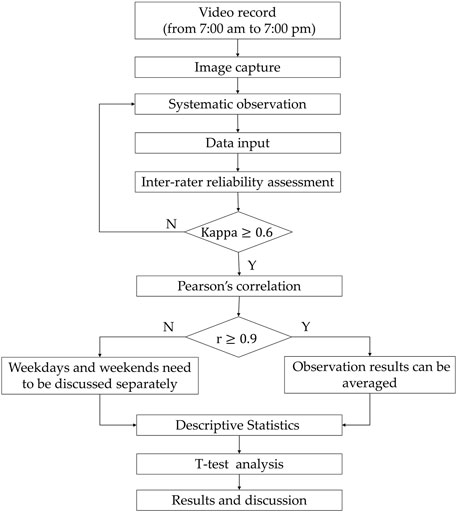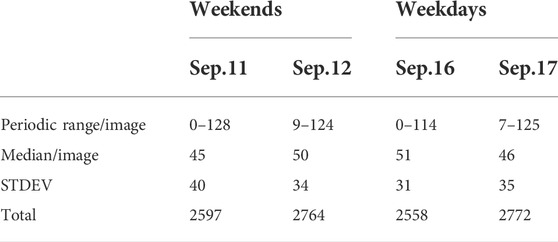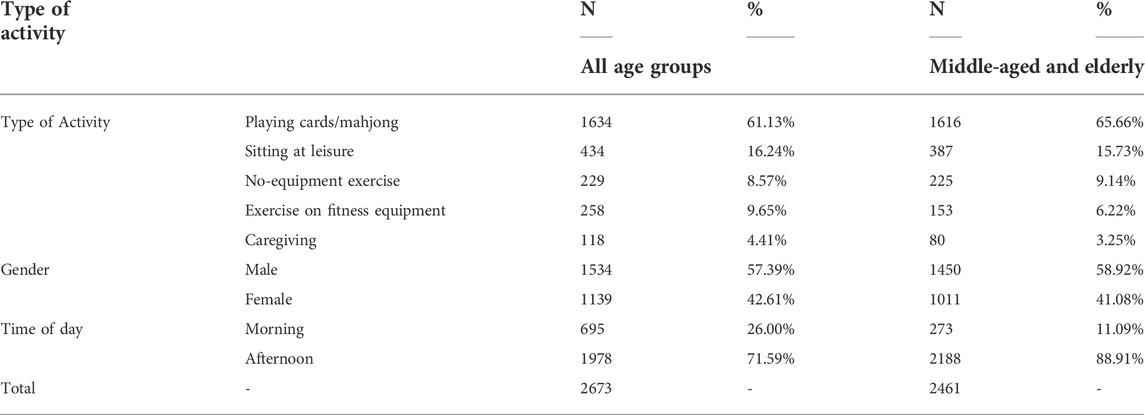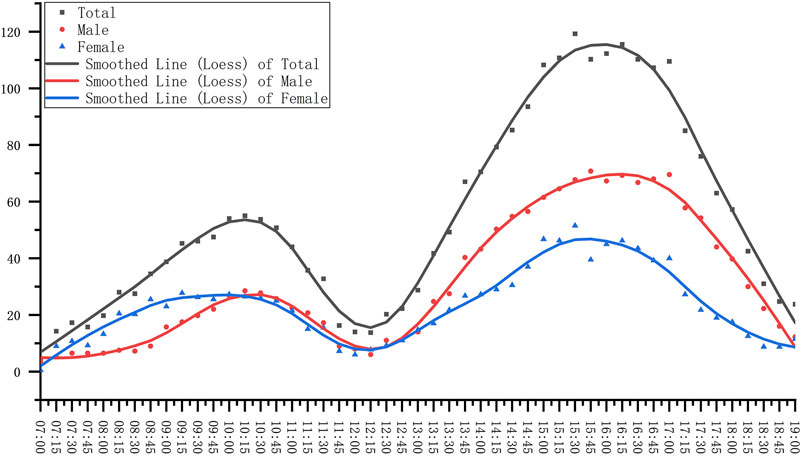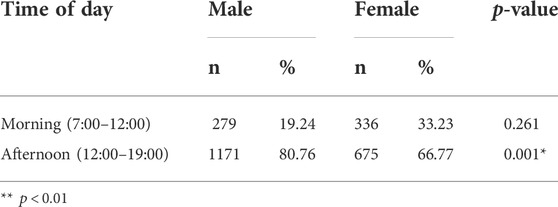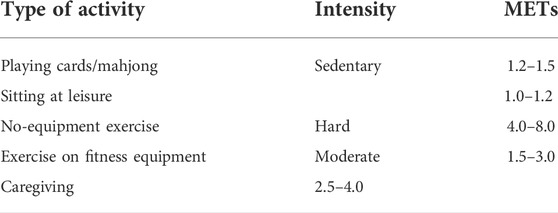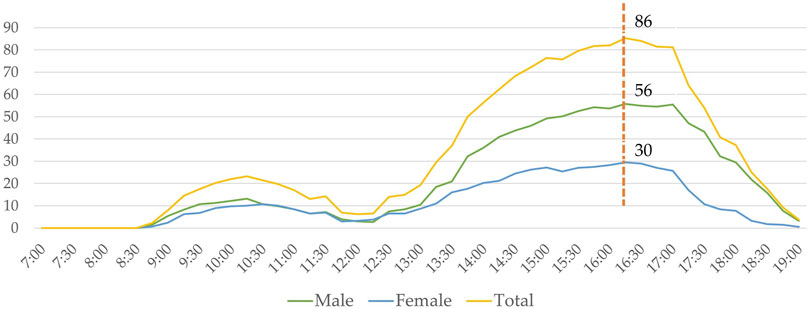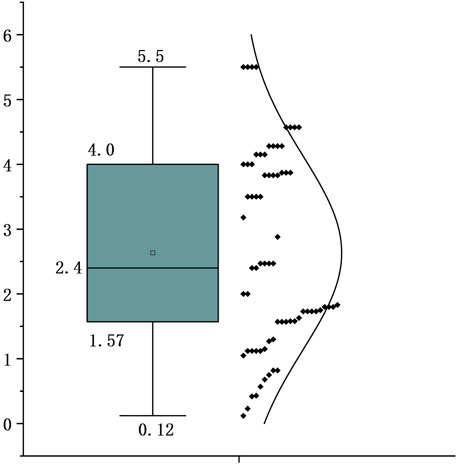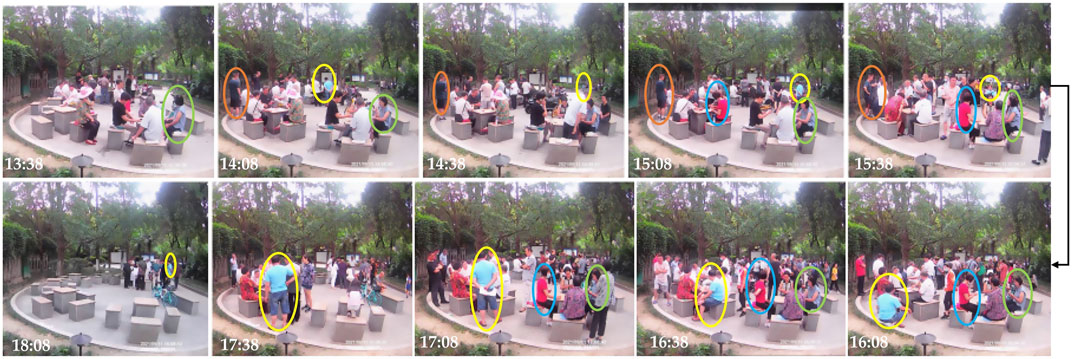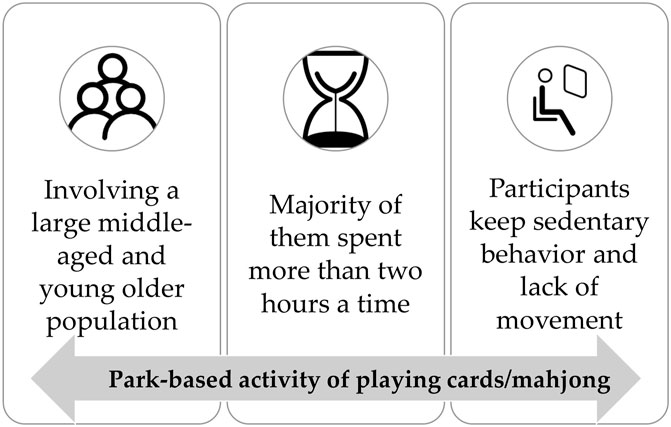- 1Sichuan Center for Land Consolidation and Rehabilitation, Chengdu, China
- 2College of Architecture and Environment, Sichuan University, Chengdu, China
- 3School of Architecture and Urban Planning, Chongqing University, Chongqing, China
- 4Key Laboratory of New Technology for Construction of Cities in Mountain Area, Chongqing University, Chongqing, China
Public parks are critical resources for physical activity (PA). Pocket parks within neighborhoods play an essential role in the elder’ daily life. A deep understanding of pocket park use and park-based PA for older adults supports the better design of outdoor spaces. Gender differences have been confirmed in previous studies. Indeed, it was observed that more males visit parks than females, and males are likely to be vigorously active. However, almost all the studies were conducted in western countries, and none has yet focused on the Chinese elderly. The main objective of this study is to investigate gender differences in park-based PA in the Chinese middle-aged and elderly population. In Zongbei Park (Chengdu, China), video recording is used from 07:00 a.m. to 07:00 p.m. to document numbers, gender, age group, and type of activity. Demographic variations of park use patterns and energy expenditure are analyzed. The study findings indicated that most users (92.05%) were middle-aged and elderly. Significant gender variations were found in the number of total and five types of activities (p < 0.01), respectively. Although more old males than females were observed in Zongbei Park, the total METs and mean METs per male were lower than females. A majority (65.66%) of the older adults were seen playing cards/mahjong. It will lead to a significant number of sedentary older adults. As China faces severe healthcare challenges due to the problem of aging, it becomes essential to construct age-friendly design pocket parks. More attention should be paid to address the park-based PA gender gap.
1 Introduction
An aging population is a worldwide phenomenon. There were 703 million people aged 65 or over in 2019, and that value is expected to double by 2050. China is one of the world’s fastest-growing aging populations (Who, 2021). According to the Seventh National Census Bulletin issued by the National Bureau of Statistics of China, the population aged 65 and over will reach 190 million by the end of 2020, representing 13.50% of the total, with an increasing rate of 4.63% compared to the previous decade. Age is the primary risk factor for the prevalent diseases (Niccoli and Partridge, 2012) and significantly burdens families and society.
Spending time in parks helps people maintain an energetic lifestyle as they age (Van Hoof et al., 2021). Parks provide versatile settings for outdoor recreation, physical activity (PA), and social connection (Veitch et al., 2022). Park visits are associated with lower blood pressure and heart rate (Van Den Berg and Custers, 2010), reduced stress and negative emotions (San Juan et al., 2017), increased perceived restorativeness (Peschardt and Stigsdotter, 2013), and decreased risk of all-cause mortality (Kim et al., 2016) across all groups of people in society. As people age, their living space shrinks (Noon and Ayalon, 2018). The pocket parks within neighborhoods supplement large parks and, to some extent, fill the need for people daily to enjoy nature, exercise, and social interaction (Nordh and Østby, 2013), especially for the elderly.
However, a review of 24 observational studies on park usage revealed that the percentage of older park users ranges from 2% to 13%, indicating an extremely low park visit among older adults (Evenson et al., 2016). As the number of older people will increase substantially over the coming decades, this juxtaposition of potential benefit with underutilization challenges the full use of parks and PA promotion in older adults (Pleson et al., 2014). Indeed, parks also provide opportunities for people to engage in sedentary behavior, and up to 70% of the visitors were found to be sedentary (Evenson et al., 2016), which has been defined as a distinct risk factor for poor health outcomes (Harvey et al., 2015).
A better understanding of the individual’s park-based PA supports the design of outdoor spaces. Physical activity behaviors are affected by factors operating at several levels, broadly perceived as personal, social, and environmental (Heath et al., 2012). Previous investigations have shown that the park spatial form (e.g., the width of the adjacent street, the average height of surrounding buildings and the number of seats (Sun et al., 2020), and social factors such as feeling safe, secure, and having peer support, and community programs (Mahmood et al., 2012) are associated with park usage among older adults. Gender differences are part of human existence and are reflected in biological structure and functions (Carmel, 2019). A study conducted in Israel found female older were more likely to integrate into spontaneous social conversions, and men were more likely to participate in familiar games (Noon and Ayalon, 2018). A review of fifty-three published literature (January 2000 –April 2011) regarding activity levels in older people concluded that men’s PA levels were higher than women’s generally (Sun et al., 2013). These findings emphasized the disparities between older males and females in outdoor PA. In park-based PA, more males than females were noticed in parks, and males were more likely to be engaged in vigorous activity (Cohen et al., 2007; Evenson et al., 2016). However, the results were drawn from all age groups, and the elderly category received less attention since they make up a small proportion (2%–13%) of the total park users. On the other side, the studies are primarily done in European and United States cities, leaving unknown about Chinese older adults. More consideration should be given to park utilization and gender difference for the Chinese elderly.
The middle-aged population (aged 45–60) is especially susceptible to health risk factors due to their apparent hormonal changes (Yuan et al., 2016). Therefore, the middle-aged and elderly as a whole (aged 45 and over) are considered in this research. Energy expenditure (EE) is one of the benefits of park visits, although not all activities are at the same intensity level (from sedentary to vigorous). More PA and less sedentary time are advantageous for individuals, particularly older adults. Our primary research questions are:1) How do Chinese middle-aged and elderly use pocket parks? 2) is there any gender difference in park-based PA? which group is more active?
Godbey et al. (2005) highlighted the need to include objective measures of PA when studying parks. The methods most widely used in objectively quantifying the park usage contain a system for observing play and recreation in communities (SOPARC), and mobile signaling data/GPS data/LBS data (Hou et al., 2020). Compared to these objective measures, video enables documenting some of these complex interactions of individuals without missing any important moments. Therefore, this study uses video recording to examine how the older adults employ the park (time of day, type of activity, and activity level) and what is the gender difference. Zongbei Park in Chengdu City was selected because it is a typical pocket park located within a residential neighborhood. It is discussed how designers and planners reduce sedentary time and promote health for the target population. The remainder of the paper’s structure is organized as follows: the “Data and Methods” section provides an in-depth description of the data and methods. The “Results” section presents the overall usage of Zongbei Park and park-based PA for the middle-aged and elderly. The “Discussion” section offers the discussion that includes the role of the pocket park for the elderly and the gender difference for older adults. Finally, conclusions are drawn from the key findings.
2 Data and methods
2.1 Study area
Zongbei Park is located in Zongbei Community in the central urban area of Chengdu City, China (Figure 1). It was built in 1992, and its area is 0.12
2.2 Data collection
In September 2021, the daily usage of Zongbei Park was continuously recorded within typical weather (no rain or other severe weather conditions), and the data were collected from 7:00 a.m. to 7:00 p.m. This analysis uses high-definition (HD) cameras (Philips VTR-8101) with a 160-Degree Wide Angle Lens. It was decided where to put the cameras based on two principles: 1) a little far away from the center so nobody will see them; 2) be able to avoid backlighting. Finally, four cameras were placed to record a time-lapse of pedestrian activities across the most-used sites of the park (Figure 2). It is worth noting that each video was tagged with the date and location for research. All relevant laws and privacy protection policies were considered when obtaining the videos.
2.3 Data interpretation
A total number of 4 days, including two weekend days (September 11 and 12) and two weekdays (September 16 and 17) were selected for the research data acquisition. The video was not fully complete due to multiple causes, including weather conditions, device discharge, or even device stealing. Video data are a continuum that can be translated into consecutive images. Previous studies have observed the parks from 1 to 14 times/day (Evenson et al., 2016). However, this leaves the information about the rest of the day missed. In this study, 1-h video was translated into four consecutive images to present the park use. This means that the park was observed 49 times/day. Accordingly, a total of 784 images captured by 4 cameras in 4 days were analyzed to obtain much more information than other studies.
Systematic observation permitted simultaneous recording of three characteristics for each park visitor. These characteristics were the approximated age group (child and teen = 2–18, youth = 13–40, and middle-aged and elder = 45+), the gender (male, female), and the type of activity (playing cards/mahjong, sitting at leisure, no-equipment exercise, exercise on fitness equipment, and caregiving). The interpretation of each type of activity is presented in Table 1. Demographic information can be distinguished by identifying individual’s facial and body characteristics. Indeed, two trained observers scanned the 784 images and recorded the characteristics of park users.
2.4 Data analysis
One research assistant entered all observation forms and double-checked by a second research assistant. Thereafter, inter-rater reliability for the systematic observation of the middle-aged and elderly age group was assessed using Kappa statistics. Kappa values were judged using an adjectival classification system created by (Landis and Koch, 1977): “almost” (≥0.80), “substantial” (0.61–0.80), “moderate” (0.41–0.60), “slight” (0.21–0.40), or “poor” (≤0.20). The analysis data include two weekdays and two weekend days. Pearson’s correlation was calculated to provide a simple and direct discussion about the relationships between these 4 days. If there is a strong correlation among the 4 days (
3 Results
3.1 Overall use
Agreement between raters for middle-aged and elderly gender groups (Kappa was 0.72 for women, and 0.68 for men) was substantial. For each day, a total of 196 images were obtained. The periodic range, median number, standard variation, and the total number of observations for each image are in Table 2. There is a median of almost 50 persons at any time, and the maximum number was estimated to be 128. It should be noted that the total number of users is not equal to the actual park visitors because some of the visitors were counted repeatedly.
Pearson correlation coefficients for the relationships between paired days were all more than 0.9 with p < 0.01, indicating strong correlations between the 4 days. Therefore, the results of 4 days were averaged to proceed with the follow-up analysis. Overall, almost all the visitors were middle-aged and elderly (92.05%), followed by the youth (5.77%). The number of children and teens only accounts for 2.17%. For both all age groups and middle-aged and elderly, the majority of people were observed to be playing cards/mahjong, male, and presented in afternoon. The descriptive statistics of the usage pattern (gender, activity type, time of day) in Zongbei Park are shown in Table 3.
3.2 Park use for middle-aged and elderly population by the time of day
LOESS curve fitting is used to present the relationships between total and group (male and female) observations and time, shown in Figure 4. It can be seen that the three curves presented a similar variation over time with a double-headed peak shape, with one maximum in the morning and one maximum in the afternoon, and the latter is much higher. During the period before 10:15 a.m., the number of older female users is higher than that of males. While after that period, more male users were observed. For the total duration, the peaks were recorded around 10:15 am. and 16:00 pm., with 53 and 115 observations, respectively.
Further analysis of the number of middle-aged and elderly male and female users in each period (morning and afternoon) were compared to highlight the difference. Table 4 shows the difference by gender group and time of day. Indeed, a statistically significant gender difference in the afternoon can be seen. The ratio of males to females using the green spaces in the afternoons is twice that in the mornings.
3.3 Park use for middle-aged and elderly population by activity type
Table 5 shows the statistics of users engaged in each type of activity tabulated by gender group. Significant gender differences were displayed according to the total number and five types of activities (
4 Discussion
4.1 The role of pocket park act for the middle-aged and elderly population
In this study, the middle-aged and elderly population constitutes a large proportion of park use (92.05%). Findings support Noon and Ayalon’s (2018) claim that small public spaces within the residential neighborhood are the extension of the private home for these people. For most park usage studies conducted in western countries, the proportion of older adults ranged from 2% (in the United States) to 13% (in Brazil). It is quite different from Chinese cities. According to the research conducted in Taiwan, around two-thirds of the park’s visitors are older adults (Pleson et al., 2014). Physical activity has a long history as a traditional health promotion method in Chinese culture (Wang and King, 2022). Most of the older adults participated in group activities, such as playing cards, dancing, and playing Tai chi, which is quite different from western countries (Cohen et al., 2007; Zhang and Lawson, 2009). The formation of these activities is rooted in Chinese traditional culture. In addition, one of the reasons that support and promote the use of parks by older adults in Chinese cities is the high residential density. Zongbei Community has a population density of almost 7.04 × 104people per km2. Zongbei Park has been a part of the Zongbei Community due to its high accessibility for the residents around.
4.2 Gender difference in park-based EE for middle-aged and elderly
Energy expenditure at a park is a combination of the intensity of activities occurring and the number of people engaging in them (Cohen et al., 2007). Metabolic equivalents (METs), which indicate the ratio of a person’s working metabolic rate relative to the resting metabolic rate, are used to calculate EE. When calculating park-based EE, the majority of previous studies used the method of adding up METs of people’s behaviors coded at the moment of observation (e.g., standing while playing basketball), even if they previously or subsequently walked or ran (Cohen et al., 2007; Besenyi et al., 2013). This approach ignores the activity’s integrity because the state of the participants changes during any activity. For example, sedentary behavior during playing cards and basketball are both coded as sedentary, making it difficult to distinguish the duration and number of people involved in long sedentary behavior. In this study, each type of activity was taken as a whole, and the PA intensity and METs of the activities were determined according to the research about sports science (Copeland et al., 2017), as shown in Table 6.
The gender differences in EE among the observed five types of activities in Zongbei Park were compared in this study. A total METs variable for each group (male and female) was calculated by taking the total number of users observed for each type of activity, multiplying each total by the respective METs value, and then adding the EE products for each type of activity. The mean MET per person was calculated by dividing the total METs by the total number of observations. The results are shown in Table 7. While more male users have been observed, the total METs of the males is slightly lower than female. In terms of indicator of mean METs per person observed, male (1.26–1.87) is much lower than female (1.87–2.99). That is to say, older Chinese men are less active in park-based PA. Gao et al. (2015) focused on leisure-time PA among Chinese older adults and found that a slightly higher percentage of women meet the widely recognized guideline—at least 150 min of leisure-time PA per week. A study of urban residents aged 40–74 years in Shanghai reported that women spent more time performing light-intensity PA and less time in sedentary behaviors than their male counterparts (Peters et al., 2010). Although the research was conducted based on different data sources and target areas, a similar conclusion has been made, which states that male Chinese older adults are less active. The finding is quite different from results for western countries, where older men’s PA levels were generally higher than women’s, and the difference ranged from 0.8% to 21.4% (Sun et al., 2013). This is of great significance for the formulation of health improvement plans for the Chinese middle-aged and elderly.
4.3 Majority’s choice: activity of cards/mahjong playing
Playing cards/mahjong accounts for 65.56% of all the five types of activities for middle-aged and elderly. Playing cards/mahjong was found to have the therapeutic effects of preserving functioning or delaying decline in specific cognitive domains (Cheng et al., 2014) and decreasing the likelihood of becoming lonely (Teh and Tey, 2019). It has also been found to be a viable treatment option for dementia (Cheng et al., 2006) and is encouraged to be adopted into the routine for the elderly to prevent loneliness as well as to maintain cognitive abilities, especially for those living alone. However, it should be noted that playing cards/mahjong is a special kind of sedentary behavior. Inactive people are more likely to develop health problems, such as non-communicable diseases, cognitive decline, depressive symptoms, disability, and physical functional decline (De Souto Barreto, 2015). Participants will benefit more significantly if they can reduce inactive behavior when playing cards/mahjong. Gaining an understanding of the daily amount of sedentary behavior measured in playing cards/mahjong is essential.
4.3.1 Characteristics of cards/mahjong playing
Older males account for 65.70% of all the playing cards/mahjong participants. It indicates that older males are more likely than females to play cards/mahjong, and this corroborates with findings obtained based on data from the Chinese Longitudinal Healthy Longevity Survey (Teh and Tey, 2019) and in Chinese communities in Sydney (Zheng et al., 2010). It could be concluded that an old Chinese male is more likely to participate in card-playing activities than a female.
Figure 5 shows the time-dependent changes in the number of users participating in playing cards/mahjong daily. It could be inferred that it happened between 09:00 a.m. and 7:00 p.m., lasting about 10 h. The number of participants reached a peak around 4:30 p.m., with a maximum of 86, consisting of 56 older males and 30 older females. It depicted the general participation trend, while the individuals’ information remains unknown. Getting the information on how many individuals joined the activity, how long they spent in the activity, and whether they keep sedentary all the time during the period will help us put forward more targeted interventions against inactivity, especially for older men.
Compared with other data types used in park use research, video helps document some complex interactions. The recorded data on 11 September 2021 is an example to get a deep understanding of the activity. The video was watched at 4x playback speed and recorded the start and departure times for the users who participated in playing cards/mahjong. During that day, all 10 table and bench sets located in Site 1, Site 2, and Site 4 were occupied for playing cards/mahjong for 4–8 h. A total number of more than 200 middle-aged and young older participated in the game, for which 71 of them were the players and the others were there to watch the game. The boxplot of time durations of the 71 players is presented in Figure 6, indicating that the minimum duration of the activity was 0.12 h, and the longest duration was 5.5 h. More than 50% of the people lasted more than 2.4 h, and more than 25% lasted more than 4.0 h. Almost 150 people on that day watched others play cards/mahjong. Their duration ranged widely from less than 2 min to more than 4 h. Some of them were attracted by the crowd and came over to stay for a short time. All the participants were sitting/squatting down/reclining/standing from the beginning to the end and were not moving for long periods.
Figure 7 gives four individual examples among the participants. The continuous states of four participant instances in playing cards/mahjong whose activity length surpasses 1.5 h (orange), 2.5 h (blue), 3.5 h (green), and 4.0 h, respectively, have been shown with the corresponding colors. It can be recognized from the video that all of them remained seated, squatted down, or reclined with little energy expenditure from the beginning to the end.
Overall, the characteristics of playing cards/mahjong may be summarized into three aspects: 1) It includes a large amount of middle-aged and young older people, with males about twice as many as females; 2) the participants spent a long time in it; 3) they remain sedentary and lack of movement during long periods (Figure 8). The integration will result in a large number of sedentary older adults. Reducing sedentary time in cards/mahjong playing and increasing benefits from the well-researched health and well-being enhancing effects of these social activities are crucial for good aging.
4.3.2 Interventions to reduce sedentary: delivering knowledge and advice
Parks play a vital role in providing the elderly’s physical activity, sedentary behavior, and inactivity in cards/mahjong playing. Exploring methods to stimulate the potential of eco-design to remind people to be less sedentary or encourage them to engage in more exercises can reach many individuals already in the park but are primarily involved in sedentary activities.
Maintaining a sedentary lifestyle may be attributed to a lack of exercise advice (Cifu et al., 2018) or knowledge about the positive effects of PA and sedentary behavior (Azevedo et al., 2007; Zhu et al., 2016). A survey was conducted among the participants and indicated that 76.92% (10/13) of them were unaware of the dangers of sitting for lengthy periods, and 61.54% (8/13) were surprised to learn how long they had been sitting while playing cards/mahjong. It was observed that it is vital to keep the participants aware of the health risks of being inactive and provide them with exercise advice and facilities to reduce the sitting time and increase the breaks. Accordingly, this study adopts the term delivering knowledge and advice as the intervention to reduce sedentary behavior and promote health for the elderly. For example, the warning words (e.g., sedentary behavior: a silent killer) could be spray-painted on the stone table to remind the users. It is a cost-effective and convenient way. Overall, effectively providing the users with knowledge and advice through park design is a significant challenge for planners and designers.
4.4 Limitations and future directions
The restrictions of this study should be addressed in future studies. Firstly, the video recording was limited to 7:00 p.m. under dimming constraints. The study did not consider nighttime park usage. According to field observation, many users are there during the nighttime. The purpose of studies that include nighttime analysis is to comprehensively describe park usage and produce more robust and pragmatic results. Secondly, four cameras were placed in this study to collect data on park usage. Although they can cover the most frequented sections of the park, they have neglected some users, particularly those appearing on the walkways. Thirdly, the video was recorded in September 2021. At that time, the weather was generally sunny and comfortable to be outside in the park, with temperatures ranging from 19 to 26°C. The results of the study did not reflect how older residents used the park during hot or cold weather. The conclusions for other seasons should be based on the behavioral data of corresponding seasons. Relevant research in other seasons, especially in summer and winter, are needed to be conducted in the future. Additionally, there is a need for further analysis to be conducted in other parks with different environmental and social-cultural contexts to enrich the understanding of park usage by Chinese older adults.
5 Conclusion
Zongbei Park within Zongbei Neighborhood is utilized as a case study to investigate gender differences in the Chinese middle-aged and elderly population of park-based PA through video recording analysis. This analysis has indicated the videotape method’s applicability and strengths in measuring park usage objectively. It showed that most (92.05%) of Zongbei park’s users are middle-aged and elderly and confirmed the importance of public spaces within a community in the lives of the middle-aged and elderly population. Significant gender differences were found in the total number and five types of activities among the middle-aged and elderly. Sedentary activities (playing cards/mahjong and sitting at leisure) were much more prevalent among males than the other three types of activities. Although more males than females used the parks, males had fewer total METs than females. Males have significantly lower mean METs per person observed than females. Therefore, there are significant gender differences in park-based PA among Chinese middle-aged and the elderly, with males being less active than females.
The majority (65.66%) of older users were observed playing cards/mahjong, and its characteristics can be summed up into three aspects: involving a large middle-aged and young older population, lasting long periods, and lack of movement. It will lead to a large number of sedentary older adults. As China encounters formidable healthcare challenges due to the problem of aging, it becomes crucial to construct age-friendly design pocket parks. The findings highlight the need for researchers, policymakers, and planners to pay attention to increasing breaks from sitting for participants in playing cards/mahjong and to tackle the gender gap in park-based PA of Chinese older adults.
Data availability statement
The raw data supporting the conclusion of this article will be made available by the authors, without undue reservation.
Author contributions
YM conceived of the presented idea. YL collected the data. All authors performed data analysis and contributed to manuscript editing and article review.
Funding
This research was supported by the opening funding of Key Laboratory of New Technology for Construction of Cities in Mountain Area (Project No.LNTCCMA-20210101), China Postdoctoral Science foundation (Project No.2021T140780), and Natural Science Foundation Project of Chongqing Science and Technology Commission (Project No.cstc2020jcyj-bshX0124).
Conflict of interest
The authors declare that the research was conducted in the absence of any commercial or financial relationships that could be construed as a potential conflict of interest.
Publisher’s note
All claims expressed in this article are solely those of the authors and do not necessarily represent those of their affiliated organizations, or those of the publisher, the editors and the reviewers. Any product that may be evaluated in this article, or claim that may be made by its manufacturer, is not guaranteed or endorsed by the publisher.
References
Azevedo, M., Araújo, C., Reichert, F., Siqueira, F., Silva, M., and Hallal, P. (2007). Gender differences in leisure-time physical activity. Int. J. Public Health 52, 8–15. doi:10.1007/s00038-006-5062-1
Besenyi, G. M., Kaczynski, A. T., Stanis, S. A. W., and Vaughan, K. B. (2013). Demographic variations in observed energy expenditure across park activity areas. Prev. Med. 56 (1), 79–81. doi:10.1016/j.ypmed.2012.10.011
Carmel, S. (2019). Health and well-being in late life: Gender differences worldwide. Front. Med. 6218, 218. doi:10.3389/fmed.2019.00218
Cheng, S., Chan, A. C. M., and Yu, E. C. S. (2006). An exploratory study of the effect of mahjong on the cognitive functioning of persons with dementia. Int. J. Geriatr. Psychiatry 21 (7), 611–617. doi:10.1002/gps.1531
Cheng, S., Chow, P. K., Song, Y., Edwin, C. S., Chan, A. C., Lee, T. M., et al. (2014). Mental and physical activities delay cognitive decline in older persons with dementia. Am. J. Geriatric Psychiatry 22 (1), 63–74. doi:10.1016/j.jagp.2013.01.060
Cifu, D. X., Lew, H. L., and Oh-Park, M. (2018). Geriatric rehabilitation. Netherlands: Elsevier Health Sciences.
Cohen, D. A., Mckenzie, T. L., Sehgal, A., Williamson, S., Golinelli, D., and Lurie, N. (2007). Contribution of public parks to physical activity. Am. J. Public Health 97 (3), 509–514. doi:10.2105/ajph.2005.072447
Copeland, J. L., Ashe, M. C., Biddle, S. J., Brown, W. J., Buman, M. P., Chastin, S., et al. (2017). Sedentary time in older adults: A critical review of measurement, associations with health, and interventions. Br. J. Sports Med. 51 (21), 1539. doi:10.1136/bjsports-2016-097210
De Souto Barreto, P. (2015). Global health agenda on non-communicable diseases: Has who set A smart goal for physical activity? Bmj 350, h23. doi:10.1136/bmj.h23
Evenson, K., Jones, S., Holliday, K., Cohen, D., and Mckenzie, T. (2016). Park characteristics, use, and physical activity: A review of studies using soparc (system for observing play and recreation in communities). Prev. Med. 86, 153. doi:10.1016/j.ypmed.2016.02.029
Gao, J., Fu, H., Li, J., and Jia, Y. (2015). Association between social and built environments and leisure-time physical activity among Chinese older adults - a multilevel analysis. Bmc Public Health 15 (1), 1317. doi:10.1186/s12889-015-2684-3
Godbey, G. C., Caldwell, L. L., Floyd, M., and Payne, L. L. (2005). Contributions of leisure studies and recreation and park management research to the active living agenda. Am. J. Prev. Med. 28 (2), 150–158. doi:10.1016/j.amepre.2004.10.027
Harvey, J. A., Chastin, S. F., and Skelton, D. A. (2015). How sedentary are older people? A systematic review of the amount of sedentary behavior. J. Aging Phys. Act. 23 (3), 471–487. doi:10.1123/japa.2014-0164
Heath, G. W., Parra, D. C., Sarmiento, O. L., Andersen, L. B., Owen, N., Goenka, S., et al. (2012). Evidence-based intervention in physical activity: Lessons from around the world. Lancet 380, 380272–380281. doi:10.1016/s0140-6736(12)60816-2
Hou, J., Chen, L., Zhang, E., Jia, H., and Long, Y. (2020). Quantifying the usage of small public spaces using deep convolutional neural network. Plos One 15 (10), E0239390. doi:10.1371/journal.pone.0239390
Kim, H., Min, J., Kim, H., and Min, K. (2016). Parks and green areas are associated with decreased risk for hyperlipidemia. Int. J. Environ. Res. Public Health 13 (12), 1205. doi:10.3390/ijerph13121205
Landis, J. R., and Koch, G. G. (1977). The measurement of observer agreement for categorical data. Biometrics 33, 159–174.
Mahmood, A., Chaudhury, H., Michael, Y. L., Campo, M., Hay, K., and Sarte, A. (2012). A photovoice documentation of the role of neighborhood physical and social environments in older adults’ physical activity in two metropolitan areas in north America. Soc. Sci. Med. 74 (8), 1180–1192. doi:10.1016/j.socscimed.2011.12.039
Niccoli, T., and Partridge, L. (2012). Ageing as A risk factor for disease. Curr. Biol. 22 (17), R741–R752. doi:10.1016/j.cub.2012.07.024
Noon, R. B., and Ayalon, L. (2018). Older adults in public open spaces: Age and gender segregation. Gerontologist 58 (1), 149–158. doi:10.1093/geront/gnx047
Nordh, H., and Østby, K. (2013). Pocket parks for people–A study of park design and use. Urban For. Urban Green. 12 (1), 12–17. doi:10.1016/j.ufug.2012.11.003
Peschardt, K. K., and Stigsdotter, U. K. (2013). Associations between park characteristics and perceived restorativeness of small public urban green spaces. Landsc. Urban Plan. 112, 11226–11239. doi:10.1016/j.landurbplan.2012.12.013
Peters, T. M., Moore, S. C., Xiang, Y. B., Yang, G., Shu, X. O., Ekelund, U., et al. (2010). Accelerometer-measured physical activity in Chinese adults. Am. J. Prev. Med. 38 (6), 583–591. doi:10.1016/j.amepre.2010.02.012
Pleson, E., Nieuwendyk, L. M., Lee, K. K., Chaddah, A., Nykiforuk, C. I., and Schopflocher, D. (2014). Understanding older adults’ usage of community green spaces in taipei, taiwan. Int. J. Environ. Res. Public Health 11 (2), 1444–1464. doi:10.3390/ijerph110201444
San Juan, C., Subiza-Pérez, M., and Vozmediano, L. (2017). Restoration and the city: The role of public urban squares. Switzerland: Frontiers Media S.A.
Sun, F., Norman, I. J., and While, A. E. (2013). Physical activity in older people: A systematic review. Bmc Public Health 13 (1), 449. doi:10.1186/1471-2458-13-449
Sun, X., Wang, L., Wang, F., and Soltani, S. (2020). Behaviors of seniors and impact of spatial form in small-scale public spaces in Chinese old city zones. Cities 107, 102894. doi:10.1016/j.cities.2020.102894
Teh, J. K., and Tey, N. P. (2019). Effects of selected leisure activities on preventing loneliness among older Chinese. Ssm-Population Health 9, 100479. doi:10.1016/j.ssmph.2019.100479
Van Den Berg, A. E., and Custers, M. H. G. (2010). Gardening promotes neuroendocrine and affective restoration from stress. J. Health Psychol. 16 (1), 3–11. doi:10.1177/1359105310365577
Van Hoof, J., Marston, H. R., Kazak, J. K., and Buffel, T. (2021). Ten questions concerning age-friendly cities and communities and the built environment. Build. Environ. 199, 107922. doi:10.1016/j.buildenv.2021.107922
Veitch, J., Ball, K., Rivera, E., Loh, V., Deforche, B., Best, K., et al. (2022). What entices older adults to parks? Identification of park features that encourage park visitation, physical activity, and social interaction. Landsc. Urban Plan. 217, 104254. doi:10.1016/j.landurbplan.2021.104254
Wang, H., and King, B. (2022). Understanding community-dwelling Chinese older adults’ engagement in physical activity: A grounded theory study. Gerontologist 62 (3), 342–351. doi:10.1093/geront/gnab069
Who (2021) Ageing and health in China. Available at: https://www.who.Int/China/Health-Topics/Ageing.
Yuan, Y., Li, F., Meng, P., You, J., Wu, M., Li, S., et al. (2016). Gender difference on the association between dietary patterns and obesity in Chinese middle-aged and elderly populations. Nutrients 8 (8), 448. doi:10.3390/nu8080448
Zhang, W., and Lawson, G. (2009). Meeting and greeting: Activities in public outdoor spaces outside high-density urban residential communities. Urban Des. Int. 14 (4), 207–214. doi:10.1057/udi.2009.19
Zheng, W. Y., Walker, M., and Blaszczynski, A. (2010). Mahjong gambling in the Chinese-Australian community in Sydney: A prevalence study. J. Gambl. Stud. 26 (3), 441–454. doi:10.1007/s10899-009-9159-3
Keywords: gender difference, Chinese middle-aged and elderly, pocket park, playing cards/mahjong, sedentary behavior, physical activity
Citation: Li Y, Niu S and Mou Y (2022) Gender difference in the chinese middle-aged and elderly of pocket park use: A case study of zongbei park. Front. Environ. Sci. 10:978935. doi: 10.3389/fenvs.2022.978935
Received: 27 June 2022; Accepted: 12 July 2022;
Published: 09 August 2022.
Edited by:
Qingsong He, Huazhong University of Science and Technology, ChinaReviewed by:
Xiang Luo, Central China Normal University, ChinaLinzi Zheng, Huazhong University of Science and Technology, China
Copyright © 2022 Li, Niu and Mou. This is an open-access article distributed under the terms of the Creative Commons Attribution License (CC BY). The use, distribution or reproduction in other forums is permitted, provided the original author(s) and the copyright owner(s) are credited and that the original publication in this journal is cited, in accordance with accepted academic practice. No use, distribution or reproduction is permitted which does not comply with these terms.
*Correspondence: Yanchuan Mou, eWFuY2h1YW5AY3F1LmVkdS5jbg==
 Yaru Li
Yaru Li Shaofei Niu2
Shaofei Niu2 Yanchuan Mou
Yanchuan Mou